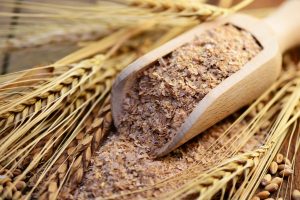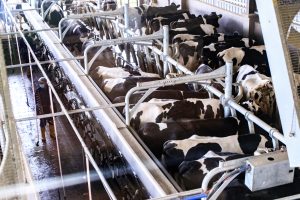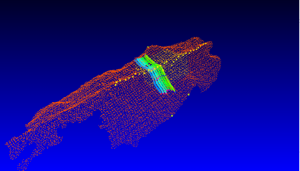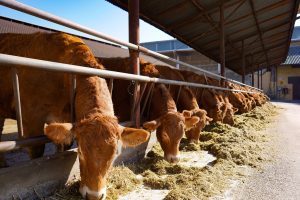Álvaro García
Maintaining a stable rumen environment is essential for optimizing performance in both cattle and sheep, especially in modern feeding systems that rely on high-concentrate or low-fiber diets, as well as on very digestible early vegetative lush pastures. Either of these feeding approaches, are rich in rapidly fermentable carbohydrates and proteins, and can lead to rapid rumen fermentation and excessive production of volatile fatty acids (VFAs), increasing the risk of ruminal acidosis. This imbalance can compromise fiber digestion, reduce feed intake, and reduce overall animal productivity. The strategic use of buffering agents like sodium bicarbonate and magnesium oxide has proven to be a reliable solution to stabilize rumen pH, prevent acid accumulation, and enhance production efficiency. By providing both immediate and sustained buffering effects, these compounds help maintain an optimal rumen environment, supporting microbial activity, nutrient utilization, and improved animal performance.
The role of roughage
Effective fiber and sodium bicarbonate play complementary roles in maintaining rumen health and motility in cattle and sheep. Effective fiber is essential for stimulating chewing and rumination, which increases saliva production—a natural source of sodium bicarbonate, a key buffer. This sodium bicarbonate helps neutralize acids; particularly volatile fatty acids (VFAs) produced during rumen fermentation of carbohydrates. Chewing longer fiber particles ensures a steady flow of saliva, helping to maintain the rumen pH within the optimal range of 5.8 to 6.5, which is critical for preventing sub-acute ruminal acidosis (SARA). However, in modern feeding systems with high-concentrate diets or during dietary transitions, saliva alone may not provide sufficient buffering capacity. This is where sodium bicarbonate supplementation becomes invaluable, as it provides a rapid and immediate response to pH drops by neutralizing excess acids in the rumen. Studies, such as Zhang et al. (2022), have demonstrated that sodium bicarbonate supplementation in high-concentrate diets not only stabilizes rumen pH but also increases feed intake and improves milk yield by 6–8%. Together, effective fiber and sodium bicarbonate support proper rumen function, promote healthy microbial activity, improve fiber digestion, and optimize nutrient utilization, all of which are essential for sustained animal performance and productivity.
Magnesium oxide: long-term buffering with added nutritional benefits
Dolomitic limestone is a natural sedimentary rock composed of calcium carbonate (CaCO₃) and magnesium carbonate (MgCO₃). While it is widely used in agriculture to neutralize acidic soils and provide essential nutrients like magnesium and calcium for plant growth, its role as a magnesium supplement for livestock is limited in its raw form. The magnesium in dolomitic limestone exists as magnesium carbonate, which has low solubility and is not readily bioavailable in the ruminant digestive system. To make it suitable for livestock supplementation, dolomitic limestone must undergo calcination, a process where it is heated to 800–1,000°C. This thermal process converts magnesium carbonate into magnesium oxide (MgO), a far more bioavailable and effective form for meeting magnesium requirements in livestock. Without processing, the magnesium in raw dolomitic limestone provides minimal nutritional benefit and cannot effectively prevent metabolic disorders like grass tetany in cattle and sheep.
Magnesium oxide (MgO) is particularly valuable as a slow-release rumen buffer, providing prolonged pH stabilization and improving rumen health. Beyond its buffering role, it serves as a critical source of magnesium, a mineral essential for nerve function, enzyme activation, and the prevention of metabolic disorders, including grass tetany. Research underscores its effectiveness: Chung et al. (2021) demonstrated that magnesium oxide supplementation improved fiber digestibility by 12% in dairy cows, leading to better feed efficiency. Similarly, Gadberry et al. (2020) reported that magnesium oxide improved growth performance and feed intake in lambs fed high-grain finishing diets. These findings highlight the significant role of magnesium oxide in supporting optimal performance in both cattle and sheep, particularly under intensive feeding conditions.
A synergistic approach to rumen health
When used together, sodium bicarbonate and magnesium oxide offer complementary buffering effects that create a robust solution for maintaining optimal rumen health. Sodium bicarbonate acts as a rapid-response buffer, immediately neutralizing excess acids in the rumen and preventing sudden pH drops caused by the fermentation of rapidly digestible carbohydrates. In contrast, magnesium oxide provides a slower, sustained buffering effect, ensuring prolonged pH stabilization over time. This dual-action approach creates a more stable and consistent rumen environment, which is critical for maintaining microbial populations, optimizing fermentation processes, and promoting efficient nutrient utilization.
The combined effects of sodium bicarbonate and magnesium oxide are particularly beneficial in modern feeding systems, where high-concentrate diets and early vegetative lush pastures increase the risk of sub-acute ruminal acidosis (SARA). By stabilizing rumen pH, these buffers reduce acid build-up, enhance fiber digestion, and improve the overall efficiency of nutrient absorption. The benefits of this combination are well-documented in recent research. For example, a study by Smith et al. (2023) demonstrated that dairy cows supplemented with both sodium bicarbonate and magnesium oxide experienced a 35% reduction in SARA incidence and a 15% increase in milk fat yield, underscoring the role of rumen stability in improving milk quality and production.
Similarly, the advantages of combined buffering extend to beef cattle operations. In a feedlot study by Lopez et al. (2021), cattle receiving both buffers achieved an 8% improvement in feed conversion efficiency compared to control groups. This improvement highlights the economic value of maintaining rumen pH, as it allows cattle to convert feed into body weight gain more efficiently. Moreover, by promoting a healthier rumen environment, the combined use of sodium bicarbonate and magnesium oxide can reduce the incidence of metabolic disorders, improve animal comfort, and support consistent growth and production performance in both dairy and beef systems.
Practical recommendations for supplementation
To optimize rumen health and animal performance, sodium bicarbonate and magnesium oxide should be supplemented at appropriate levels based on the species and production system. For dairy cows, sodium bicarbonate is recommended at 0.75–1% of dry matter (DM), while magnesium oxide should be included at 0.3–0.5% of DM. In beef cattle, effective levels are slightly lower, with sodium bicarbonate at 0.5–0.8% of DM and magnesium oxide at 0.2–0.4% of DM. Sheep require more modest supplementation, with sodium bicarbonate at 0.5% of DM and magnesium oxide at 0.2–0.3% of DM.
To simplify practical application for smaller operations or individualized feeding, these amounts can be translated to spoon measurements based on animal liveweight. For every 100 kg of liveweight:
- Sodium bicarbonate: 2 overfilled tablespoons heap (~30 grams)
- Magnesium oxide: 1 flat tablespoon (~15 grams)
When incorporated into total mixed rations or offered as free-choice supplements, this dual-buffering strategy helps maintain rumen pH, improve nutrient utilization, and mitigate the risk of ruminal acidosis. Combining the fast-acting buffering action of sodium bicarbonate with the prolonged effects of magnesium oxide provides a balanced approach to rumen stabilization for high-producing dairy cows, growing beef cattle, and finishing lambs.
© 2025 Dellait Knowledge Center. All Rights Reserved.









